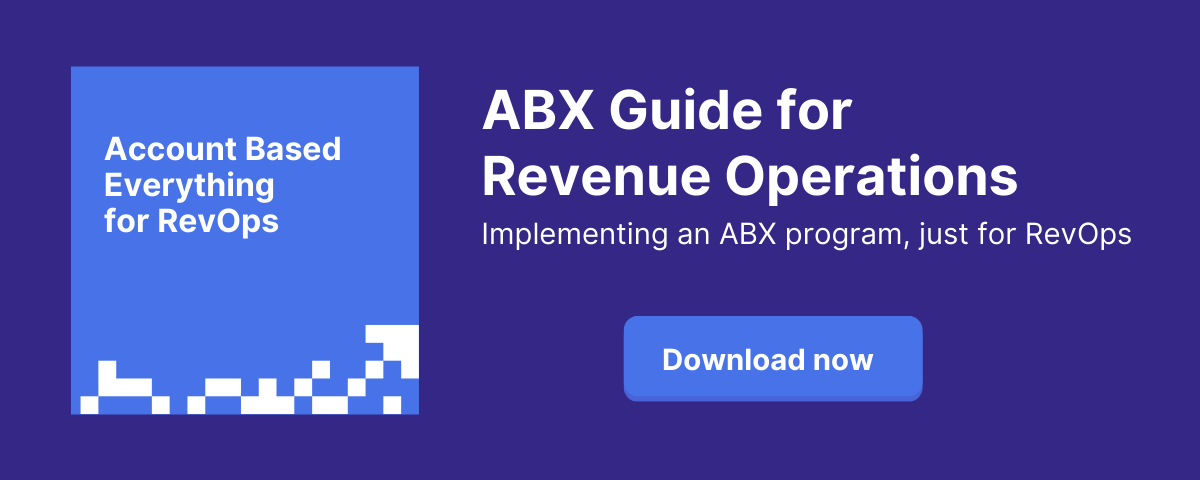In B2B revenue organizations, sales reps should own accounts - and only accounts. The reason is simple. Businesses are your customers, not individuals. And, well, accounts represent businesses. This seemingly simple statement has far reaching implications for how you construct your processes and your teams.
Now, I understand that any specific buying decision is made by an individual (or, let’s be honest, usually a committee) within a specific business, so this isn’t an argument that you shouldn’t build relationships with your influencers, decision makers, technical buyers, etc. In fact, if anything I’m proposing you (strategically) do more of that. These relationships are critical and necessary. After all, a person has to sign the contract. That single person is not, however, sufficient in a B2B context.
The reason personal relationships aren’t sufficient is another simple statement: companies outlast an individual’s role. Points of contact leave jobs, decision makers get promoted and aren’t as focused on your solution; the list goes on. If you’re going to maximize LTV, your relationship with the customer has to be able to survive these situations. This also applies to your organization. Your reps leave, you promote your people, your leaders come and go, but your business has to retain the businesses that are your customers. That’s why we call this whole thing Business-to-Business.
The only way to generate lasting value for your business is to make sure it’s built to maintain relationships and deliver value to other businesses over the long term in the face of changing individual roles. And that means you need to align your organization around accounts, not individuals.
This is where account based marketing comes in
The ideas above aren’t new insights. They’re some of the basic concepts behind Account-Based Marketing (ABM). Despite the name, ABM isn’t a marketing tactic. It got its start in the marketing world as a way to target businesses (instead of individuals) with ads but it has since evolved into a fundamental way of thinking about your GTM approach that means focusing on engaging, converting and retaining accounts that fit your ideal customer profile.
Let’s compare ABM to a more traditional transactional approach. In a transactional model, your job is to convince someone to purchase a product or service within a single sales cycle. You either win or you lose. ABM takes a broader view. You know which businesses should be your customers, so you engage them over time - often over multiple sales cycles. You tailor your messages to different folks within the account (the executives, the decision makers, the influencers) to ultimately build broad-based support for your solution. If you lose an individual sales cycle, you derive information you can use in future sales cycles. For example, the account’s under contract with a competitor for the next 6 months, they just hired a new leader who’s going to look at this issue in Q1, or the team is just too small right now to deal with this issue. That information makes your next outreach even better, even more targeted and, at some point, even more successful. To use a sports metaphor, the transactional model is about winning an individual game, while ABM is about winning the championship over the course of a season.
This all sounds great; who doesn’t want to win championships? But there’s just one problem. Reps can’t talk to accounts. They talk to, you know, people. When somebody goes to your website and fills out that lead form, you just need to assign that lead to a rep to go call ‘em, right?
In the grand tradition of improv teachings applied to business: “Yes, and”. There’s more to it than that.
We need to change how we think about leads
A lead isn’t something you just go off and work to close a deal. A lead is a signal that tells you one very important thing: there is interest in your solution at a particular account. The individual signaling interest matters, but less than you think.
Here’s why. People rarely go rummage around vendor websites requesting demos or filling out contact forms for fun. A more likely scenario is that this request is the result of some internal discussion. During that discussion someone got assigned the task of looking for a solution to a business problem. And guess what? It’s highly unlikely the person who got assigned that task is a decision maker except at very small companies or for very small purchases. This results in a bit of upside down logic: the lead is an incredible buying signal for the account but the individual associated with the lead is likely only tangentially relevant to successfully converting that account to a customer.
You resolve this conundrum by working the account, not the lead. When you get inbound interest, you assign the interested account to a rep so they can work that account, starting with the person that inbounded and then working out from there. It might sound like a small change in mindset but the impact is large. If you change your perspective on inbounds such that you don’t “work a lead” but you instead “work an account that’s signaling interest”, a lot of things become clear.
The most important thing you realize is that Leads are bad. Sorry, let me clarify… Salesforce’s Leads are bad. They create a “Lead Leak” that pollutes your CRM and your processes over time while also creating more opportunities for missed follow-up. Even if you use a different CRM, you likely have some of the same issues so it’s worth continuing to read. (I promise!)
(Note that in the paragraphs below I’ll use capital Lead, Contact, Account, etc to refer to the Salesforce versions of those “objects”.)
Back at the turn of the century when Salesforce still sported a “No Software” badge on their now ubiquitous cloud logo, they made a fateful decision. Accounts (businesses we can sell to), Contacts (people at businesses we can sell to) and Opportunities (a specific sales cycle) would be separate from Leads. Leads would represent some sort of embryonic amalgamation of all three. At some undetermined point in time we’d press a button to “convert” the lead and it would be born anew as an Account, Contact and (optionally!) an Opportunity. This doesn’t make a whole lot of sense, but Salesforce has had a very busy 20 years de-serifing their cloud logo, building a glass monument to the Ohana, and filling Marc Benioff’s trophy case with enough deal tombstones to keep a small army of lucite engravers occupied - so they just haven’t had time to fix it. Instead we’ve been left to our own devices to work around this truly odd behavior in the world’s biggest CRM.
Even in the simple case this wreaks havoc. A brand new person you’ve never interacted with before requests a demo and a Lead gets created in Salesforce. You assign that Lead to a rep to qualify it. If that interest is qualified in any way, your rep then converts the lead and now you have an Account, Contact and Opportunity. (The Lead, by the way, essentially disappears into the ether.) This means that any reps qualifying inbounds end up owning a mix of Leads, Accounts, Contacts and Opportunities. This is a recipe for disaster which we’ll get to shortly.
Now consider a relatively complex case. Let’s say someone requests a demo - we’ll call them Bob - under the email bob@acme.com. Acme, it turns out, is already a prospect and Bob has reached out before, so he’s already a contact. The lead still gets created but if we just worked it directly like in the first case, we’d be stepping on the metaphorical toes of another rep who’s already engaged in a sales cycle. That’s not great.
So what do we do? We have to build in some form of “matching” that tries to connect a Lead back to an Account so we can be sure that it’s actually net new. We might look at the domain name in an email address, the company name, the person’s name, their location or any other attribute and try to find some existing Account, Contact and/or other Lead record that already exists in the system. If we find multiple records that seem to match, we need to rank them so we have a way of picking the best. Oh and don’t forget, this all needs to happen within your SLA so the customer doesn’t lose interest and go buy their TNT from someone else.
It should be clear at this point that this quickly gets ridiculously hairy as we attempt to do a 3-way fuzzy match while also conforming to RoE and whatever other territory design rules we’ve put in place. That’s before we even consider the massive data quality implications that come from missed matches potentially causing duplicates to be created. That’s the bad news.
Unfortunately there’s no good news (yet). Only worse news. This complex case isn’t special. It’s got to be done for every lead every time because we can’t even do the simple case until we’ve verified that there’s nothing to match. The technical term for all of this is, I believe, a “massive pain in the ass”.
You have to figure out account ownership
And just to add insult to injury… Even if you get your matching reasonably right, you still have to solve for ownership. Do you assign it to the owner of the matching account? Convert the lead and notify the current owner? Ignore account ownership and allow a rep to run with an individual opportunity?
In my customer development conversations at Gradient Works, I’ve seen a lot of different solutions to this ownership problem. One of the most common, I’m afraid, is to focus reps on owning leads and opportunities and semi-ignore the account. This almost invariably means that reps end up owning leads, accounts and opportunities.
This way lies madness. With this kind of heterogeneous ownership, reps struggle to have a unified view of their follow ups, managers can’t track activity and forecasting becomes much more complex because you have to continually build a single view of the world from different places. And most importantly, you’re no longer focusing on the entity that actually buys from you: the account. You’re also missing out on the strategic benefits of engaging with and gathering information on an account over the long term per ABM concepts.
The solution to all this is to make accounts your “unit of ownership” within your sales process. This has largely been true in the enterprise world and for account management “post-sales” (which is not a thing, but that’s another blog post). It should also be the case for new business even in higher velocity B2B sales. If you do this, you get the benefits of ABM principles while also getting the benefit of a much clearer picture of rep books. This simplifies rep follow-up, activity tracking and forecasting. And - I’ll say it one more time - it ensures your reps are aligned to your actual customer: the account.
So how do you plug the lead leak and make sure that you’re only dealing with accounts? Treat leads as the account buying signal they are and immediately convert them (or relate them) with accounts. Then make sure those accounts are what get assigned.
This requires lead-to-account matching
This leads (see what I did there?) us back to lead-to-account matching, which is a big topic by itself. However, I’ve often seen it get radically overcomplicated. Since we’ve spent quite a bit of time in thinkpiece territory and you’ve gotten this far I want to leave you with some concrete recommendations for how to match leads to accounts.
Start simple and focus on the domain. The overwhelming majority of your potential B2B customers have websites. Since web domains are guaranteed to be unique, they’re about as close to a universal identifier for a company as you’ll find. Not only does it apply to an account (via the website), it also associates an individual with a company via an email address. It’s also free and there are a ton of technical tools to help you work with them. Therefore, you should build the foundation of your matching by connecting the email address of a lead to the domain of an account.
To implement domain-based matching well, you’ve got to have your data in a good place. I recommend the following steps:
- Ask for it. As much as possible, restrict inbound lead generation to require company email addresses and avoid public webmail addresses (e.g. gmail, yahoo, etc). If a lead isn’t interested in handing over their work email address that’s often a sign that they’re either a) not actually very interested or b) not a business. In my experience this is usually a negotiation between sales and marketing about quantity vs quality. Good luck.
- Require it in CRM. Ensure that a website or domain is specified for an Account in your CRM using data validation rules. If you can’t require it, perform regular audits to ensure that they get populated.
- Normalize it. One challenge with “Website” fields is they tend to get populated with all sorts of information in all sorts of formats (e.g. with and without http/https, with and without extra path information). Add some code in your CRM to extract just the domain part of the URL (e.g. “https://example.com/1234” becomes just “example.com”) or email address (e.g. “bob@acme.com” becomes “acme.com”) and store it in a custom field on the Lead and Account. Some data enrichment tools will help automatically do this for you.
- Clean up subdomains. It’s usually a good idea to remove any subdomains when doing normalization, especially “www” (e.g. “www.example.com” because just “example.com”). However, this can cause problems with some hosted subdomains (e.g. acme.squarespace.com or retailer.shopify.com). When in doubt, only suppress certain subdomains like “www”.
- Use domain aliases. Many companies have more than one domain. This ranges from simple aliases (microsoft.com and microsoft.net) to regional domains (microsoft.com and microsoft.co.uk) to more complex scenarios like subsidiaries (microsoft.com and xbox.com). You should consider setting up a related list on the Account with domain aliases and checking that alias list when doing matching. How you want to match these will often be intimately related to how you decide to segment accounts (e.g. by global region, separate owners per subsidiary).
- Make it unique. Use duplicate detection rules in your CRM to make sure that accounts don’t get created that have the same domain.
With clean data in hand, you can then use various tools provided by your marketing automation, CRM or other products in your stack to match a domain associated with a lead to a domain associated with an account. If there’s a match, you can associate the lead information to the existing account. If there’s no match, you can be reasonably confident in creating a new account and associating the lead information with that. From there, you can assign ownership of the account to a rep per your assignment rules. I don’t mean to handwave the workflow here; this is as complicated as cleaning the data. I plan to have more to say on it in the future.
Plug the lead leak for more predictable growth in 2021
If you’ve been living in a world where reps own leads, opportunities and/or accounts instead of having a single unified ownership structure built around accounts, I recommend you think about whether your process could be improved by re-focusing your energy on your actual customers: the accounts themselves. Like everything else in the revenue organization there are people, process and technology challenges in implementing a different model but the strategic, tactical and data quality benefits to account ownership outweigh those. Invest now in plugging the lead leak and you’ll position yourself well for faster, easier growth in 2021.





